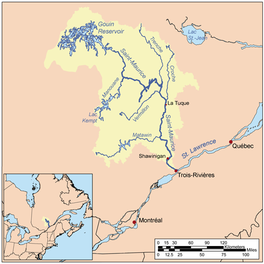|
Hanotaux Bay
The Hanotaux Bay is a freshwater body located in the south-west part of Gouin Reservoir, in the territory of the town of La Tuque, in the administrative region of Mauricie, in the province of Quebec, in Canada. This bay extends mainly in the canton of Hanotaux (part South-East) in the south-western part of the Gouin Reservoir. This bay is partially overflowing in Crémazie township (east side) and Poisson township (south side). Recreotourism activities are the main economic activity of the sector. Forestry comes second. A forest road running west of Pascagama River serves Hanotaux Bay. The R1009 Forest Road runs from the west side of Mattawa Bay into the lower Flapjack River into the northern part of Hanotaux Bay and the southern portion of Bureau Lake (Gouin Reservoir). This R1009 road joins the Southeast route 404 which serves the northern part of the Canadian National Railway. The surface of Hanotaux Bay is usually frozen from mid-November to the end of April, however, safe ice circulation is generally from early December to late March. GeographyThe main hydrographic slopes near Hanotaux Bay are:
Hanotaux Bay, which is a length of 8.0 kilometres (5.0 mi), is shaped like a deformed X with an archipelago of about fifty islands at its center. This X is described as follows:
The current from the Adolphe-Poisson Bay bypasses the South on 5.0 kilometres (3.1 mi) and by the North on 6.1 kilometres (3.8 mi), an island (length: 5.5 kilometres (3.4 mi)) which delimits the southern part of the mouth of Hanotaux Bay. On the north side of this island, waters from the Adolphe-Poisson Bay mix with the waters of Hanotaux Bay near the mouth of the bay. Hanotaux Bay is mainly fed by the Adolphe-Poisson Bay outlet, which is itself fed by Bignell Creek (on the south side) and by the Lake of the Poète (West side) via the Piciw Minikanan Bay. This canal was built at the same time as the Mégiscane Dam at the mouth of the Du Poète Lake, thus diverting the water from the upper part of the Mégiscane River to Gouin Reservoir via the Adolphe-Poisson Bay, then the Hanotaux bay. The mouth of Hanotaux Bay is located in the Southeast at:
From the mouth of Hanotaux Bay (located between the large island at the mouth of the Adolphe-Poisson Bay) and the peninsula from the North, the current flows over 122.8 kilometres (76.3 mi) to Gouin Dam, according to the following segments:
From this dam, the current flows along the Saint-Maurice River to Trois-Rivières. ToponymyThis hydronym evokes the work of life of the academician Gabriel Hanotaux (Beaurevoir, Ainse, 1853 - Paris, 1944) including his participation in the First Congress of the French language in Canada held in Quebec City in 1912 Hanotaux was president of the Champlain Mission composed of several French personalities, politicians and men of letters. Gabriel Hanotaux has had a prestigious career. Archivist-paleographer, Hanotaux is a professor at the "Ecole des Hautes Etudes" before becoming a Foreign Affairs Attaché and fulfilling several diplomatic missions, notably in Constantinople. Member of the Aisne (1886), he was Minister of Foreign Affairs from 1894 to 1898. He devoted himself thereafter to his work as a historian. Specialist of Richelieu and Egyptian history, Hanotaux directs, between 1920 and 1929, the publication "Histoire de la nation française" (‘English: "History of the French nation") whose first volume contains the important "Human Geography of France", written by Jean Brunhes. From 1930 to 1934, he published, in collaboration, a History of the French colonies and the expansion of France in the world, a work where Canada and Quebec occupy a good place. The toponym "Baie Hanotaux" was adopted by the Commission de géographie, the current Commission de toponymie du Québec, on July 5, 1951.[2] The toponym "Baie Hanotaux" was formalized on June 12, 1970, by the Commission de toponymie du Québec.[3] Notes and references
See also
|
||||||||||||||||||||||||||
Portal di Ensiklopedia Dunia

